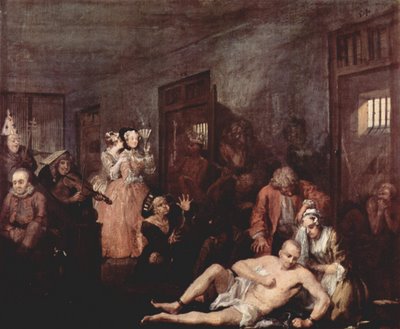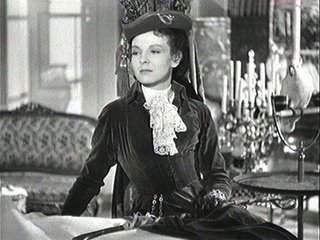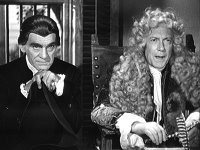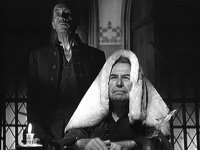
Bedlam (1946)
Director: Mark Robson
Among the classic films of horror are a subgroup that I’m going to call “eerie.” These films are not really horrifying and generally do not include nonhuman monsters or otherworldly creatures, such as ghosts. Rather, they tap more directly into the human capacity for cruelty and subversion to generate their unsettling mood. The acknowledged master of the eerie was producer/writer Val Lewton, whose films for RKO Radio Pictures are stylish, distinctive, and very, very good.
Among Lewton's acknowledged masterpieces are I Walked with a Zombie (1943), The Leopard Man (1943), and The Body Snatcher (1945). Bedlam was inspired by the engravings of William Hogarth of London's notorious Royal Hospital of St. Mary's of Bethlehem, an asylum for the insane better known as Bedlam. Indeed, Lewton gave Hogarth (1697-1764) a writing credit, so much does the atmosphere of the picture derive from Hogarth's tortured rendering of Bedlam's inmates in The Rake's Progress. The film opens on a man hanging by his fingertips from the gutter of a roof, trying to pull himself up. A guard walks over and crushes the man's fingers under his boot, loosening his grip and sending him plummeting to his death. A carriage transporting the fat and lazy-minded Lord Mortimer (Billy House) and his pretty and quick-witted companion Nell Bowen (Anna Lee) stops at the scene. Mortimer knew the dead man and questions why he died in an insane asylum, angrily demanding that the head warden, George Sims (Boris Karloff), make a full explanation at his chambers the next day. Nell grows curious about Bedlam, and Mortimer informs her that for tuppence, anyone can take a tour of Bedlam and laugh at the "animals" in their cages.
The film opens on a man hanging by his fingertips from the gutter of a roof, trying to pull himself up. A guard walks over and crushes the man's fingers under his boot, loosening his grip and sending him plummeting to his death. A carriage transporting the fat and lazy-minded Lord Mortimer (Billy House) and his pretty and quick-witted companion Nell Bowen (Anna Lee) stops at the scene. Mortimer knew the dead man and questions why he died in an insane asylum, angrily demanding that the head warden, George Sims (Boris Karloff), make a full explanation at his chambers the next day. Nell grows curious about Bedlam, and Mortimer informs her that for tuppence, anyone can take a tour of Bedlam and laugh at the "animals" in their cages.
Sims toadies slavishly to Mortimer to appease him, but Nell is revolted by Sims. She makes a visit to Bedlam and pays her tuppence, but is frightened by the faces and movements of the inmates. She runs off, encountering a Quaker stonemason named Hannay (Richard Fraser) who has just been turned down for a commission at the asylum because he will not overcharge and kick back the overage to the asylum. He believes she felt compassion for the poor wretches in Bedlam, but she sneers that she feels nothing but contempt. She is a very hard case, it seems, but she later petitions Mortimer to upgrade their living conditions, trying to persuade him that it would be amusing.
Sims counters that he could provide better amusement by having his loonies put on a play for Mortimer and his friends. One of his performers, covered in gilt dust, dies of asphyxiation. Nell  decides to make war on Sims. Sims attempts to get her out of the way by persuading Mortimer to offer her money to go to the spa at Bath. She takes the money, puts it between two pieces of bread, and takes a bite out of it. This rash act will be used against her in a trial at which Sims succeeds in having her committed to Bedlam.
decides to make war on Sims. Sims attempts to get her out of the way by persuading Mortimer to offer her money to go to the spa at Bath. She takes the money, puts it between two pieces of bread, and takes a bite out of it. This rash act will be used against her in a trial at which Sims succeeds in having her committed to Bedlam. The sane person locked away in a madhouse is a familiar horror fantasy, and the inside of Bedlam is indeed menacing, filled with shadows and shadowy figures groping in the dark. But Lewton and Robson are reform-minded and make their inmates sad, mistreated creatures, Nell their guardian angel, and Sims the cruel taskmaster who tries to justify his actions by the necessity of going along to get along to a kangaroo court of inmates who waylay him. We have seen him stroke the cheek of a catatonic woman, however, and can imagine that this is a subtle way of suggesting that he regularly gropes her. Karloff, of course, is punished for his depravity, and we are told in a title card that reforms come to Bedlam in the years that follow.
The sane person locked away in a madhouse is a familiar horror fantasy, and the inside of Bedlam is indeed menacing, filled with shadows and shadowy figures groping in the dark. But Lewton and Robson are reform-minded and make their inmates sad, mistreated creatures, Nell their guardian angel, and Sims the cruel taskmaster who tries to justify his actions by the necessity of going along to get along to a kangaroo court of inmates who waylay him. We have seen him stroke the cheek of a catatonic woman, however, and can imagine that this is a subtle way of suggesting that he regularly gropes her. Karloff, of course, is punished for his depravity, and we are told in a title card that reforms come to Bedlam in the years that follow.
Karloff is very good in this role. He had grown sick of the grotesques Universal had cast him as, and relished the opportunity to play a real, if deviant, man for RKO and Lewton. He would give several strong performances for them in other pictures, but most particularly in The Body Snatcher, perhaps his best performance and film.
Anna Lee plays an ordinary woman who tries to fit into the amorality of her adopted class. She puts on a very tough and callous front, but her basic decency wins out. Lee, however, is a little too hard and softens so subtly that it's hard to notice a change in anything but her behavior. When she appears to be starting a romance with Hannay, it just doesn't ring true. Lee does not have the chops to properly shade her Nell. On the other hand, I was very taken with Fraser as Hannay. I enjoyed his gentle, but shrewd manner, and he seemed to use "thee" and "thou" with an ease that would suggest this verbal twist favored by Quakers at the time was absolutely natural to him.
Most of all, I loved the look of this film. It is a tribute to cinematographer Nicholas Musuraca that he could recreate the look of Hogarth's engravings so vividly on camera. This is an atmospheric film, a first-rate example of the eerie genre that seeks to unsettle and, possibly, to teach. l
The Val Lewton Horror Collection boxed set of DVDs is available widely and includes Cat People / The Curse of the Cat People / I Walked with a Zombie / The Body Snatcher / Isle of the Dead / Bedlam / The Leopard Man / The Ghost Ship / The Seventh Victim / Shadows in the Dark.
For a first-rate discussion of The Leopard Man and Henri-Georges Clouzot's Le Corbeau, read our own Roderick Heath at http://www.brightlightsfilm.com/50/leopardraven.htm


2 Comments:
At 7:28 PM, Anonymous said…
Anonymous said…
Aw, jeez, shucks, Mare.
Great review of Bedlam, a very ambitious film thematically. It's worth noting that Val Lewton strenuously protested being given Boris Karloff to star because of Karloff's cliched horror cache, but he brought a marvellous centre to the films where the chief weakness of the earlier Lewton films was their lack of a strong, compelling actor. Tom Conway didn't cut it.
Whenever we see Ian Wolfe in a film, no matter how many he was in, we always say, "Oh look, it's the greatest advocate of them all!"
At 9:26 AM, Marilyn said…
Marilyn said…
I love that character, too, Rod.
I also find the sane man locked up in Bedlam to keep him away from drink so that he can write interesting. I wonder if it's a commentary by Lewton about working in the movies.
Post a Comment
<< Home